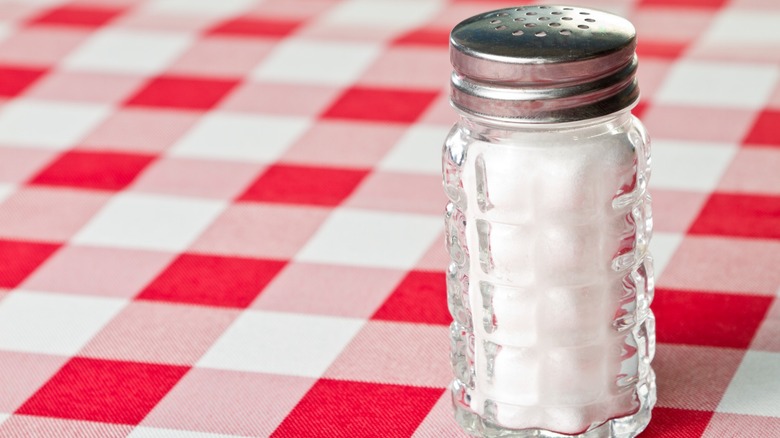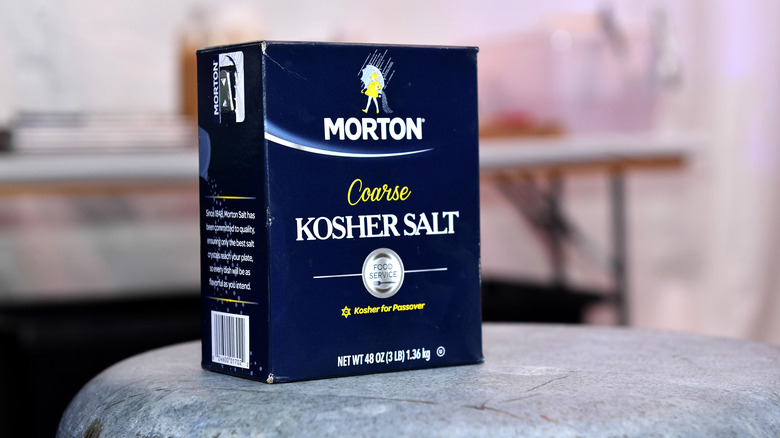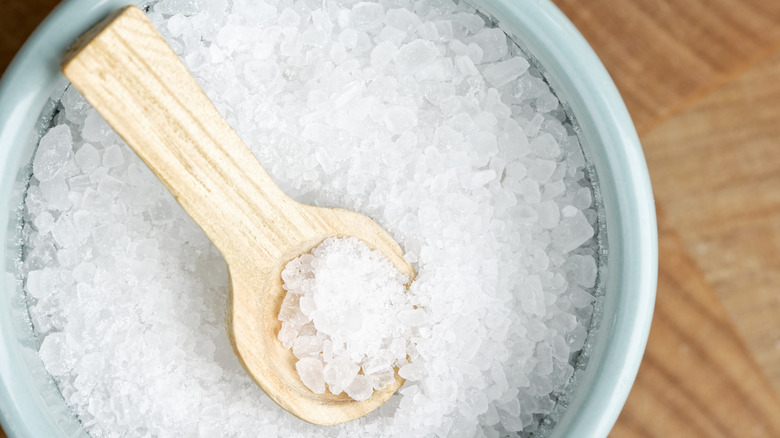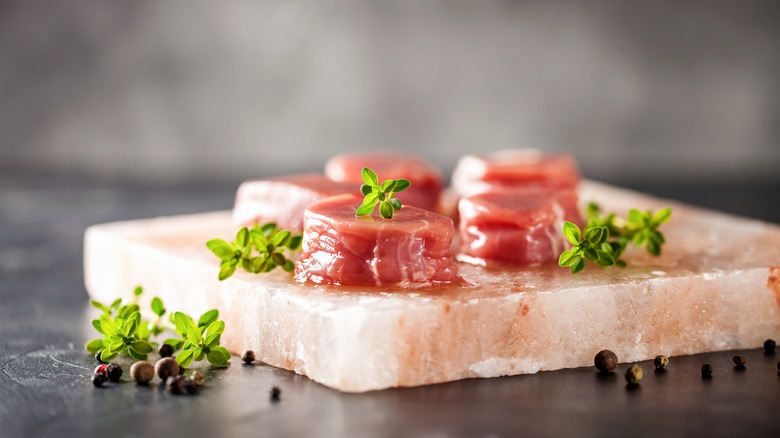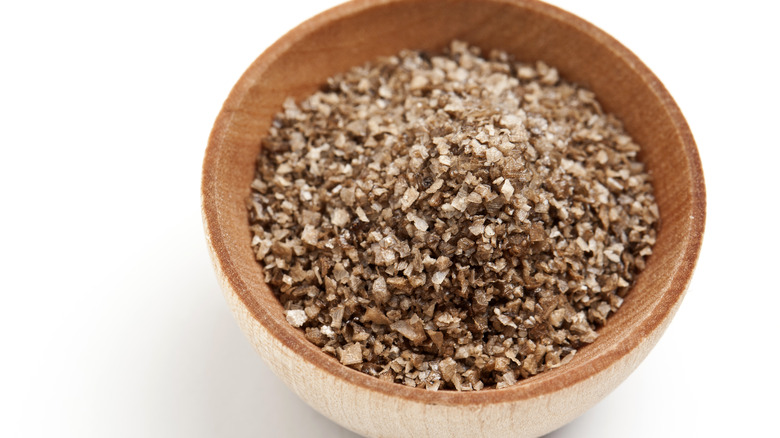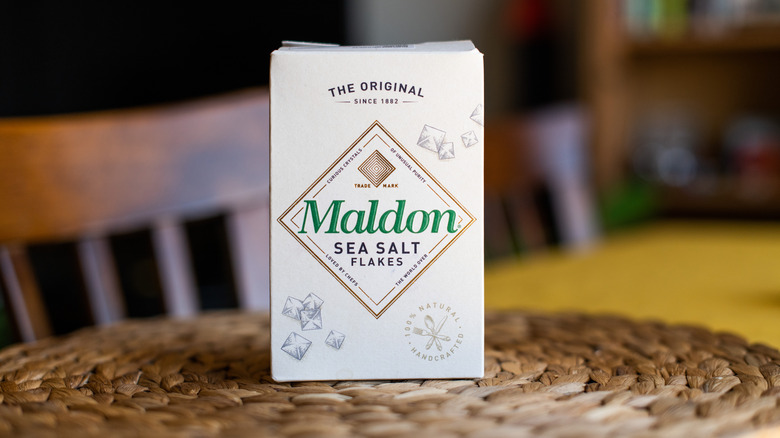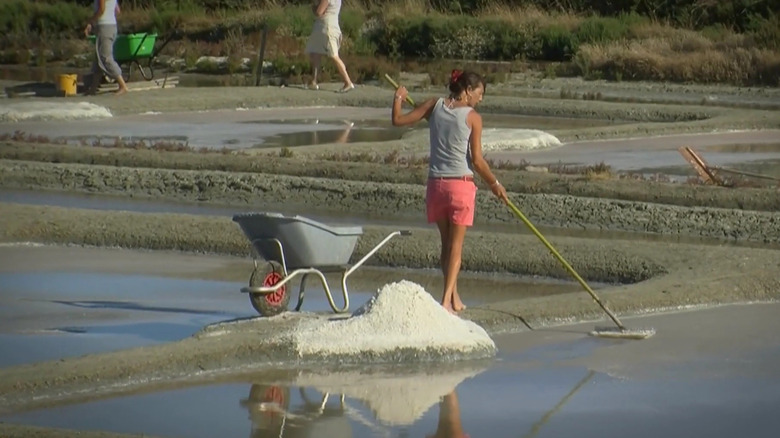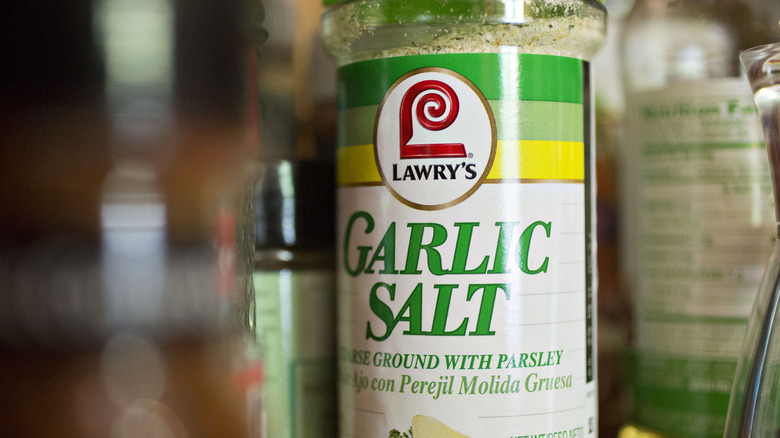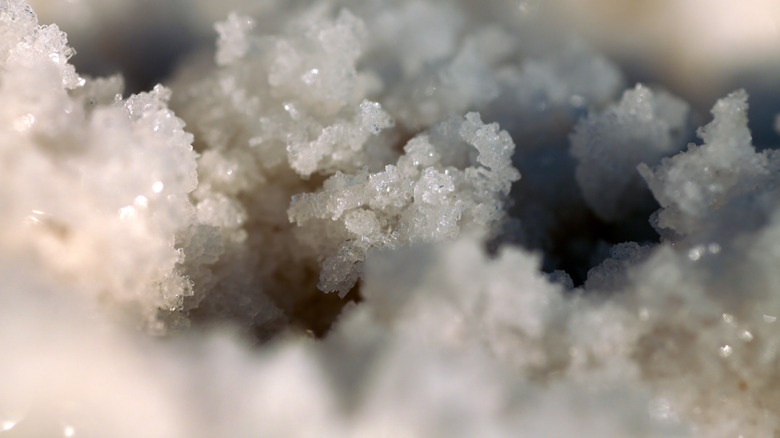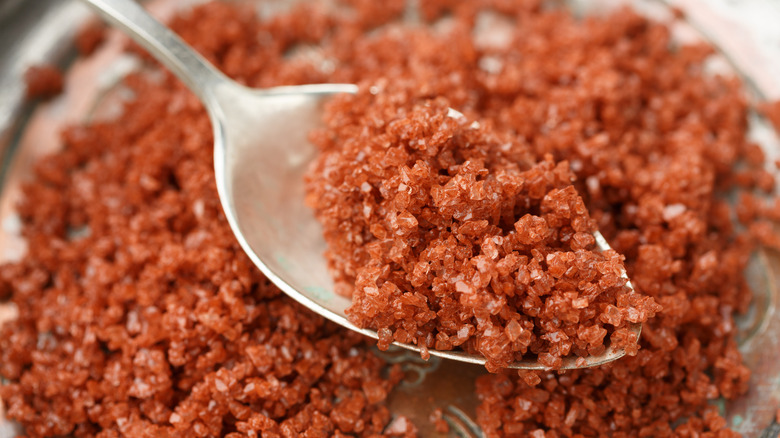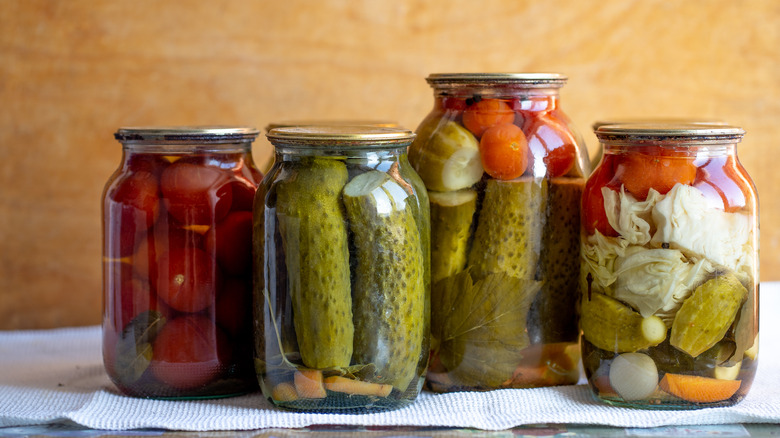12 Types Of Salt And When To Use Them
From as early as 6000 B.C., humans were harvesting salt from natural sources and using it to flavor their food. As of 2700 B.C., over 40 different types of salt were known to Ancient Chinese communities as well as two extraction and processing methods. As time progressed, salt use became more widespread; it was used to preserve food, treat wounds, and tan leather. As a precious commodity, salt was the basis of numerous conflicts and was famously used as currency in Ancient Roman armies.
Today, salt is viewed in a much different light. Instead of being a scarce, highly valued resource, it is an abundant, widely available product. Whereas our ancestors were worried about not having enough salt, most modern Americans are consuming too much, an overindulgence that largely results from the ingestion of highly processed foods. When cooking our own food, salt is often viewed as an afterthought. One type is usually used for every culinary task. While common, this practice is far from ideal.
Most salt, including table, sea, or rock, is nearly 100% sodium chloride. Only slight variations in composition account for differences from one type to another. These differences, however small, do result in each salt having its own characteristics. As a result, every type of salt is suited to a few, particular culinary tasks.
Table salt
Table salt is a finely-grained, uniform type of salt that's commonly used across the world. The salt is usually harvested via solution mining wherein terrestrial salt deposits are accessed via a borehole. This borehole is filled with water and the salt deposits subsequently dissolve. The resulting saline solution is pumped to the surface and the water is evaporated. Salt deposits are left behind and are consequently milled. This creates the small, uniform granules of table salt we are all familiar with. Finally, anti-caking agents are added to the salt to prevent it from clumping.
The small, regular shape of table salt grains means a great deal of table salt can be packed into a small space. For this reason, one cup of table salt will be twice as powerful as one cup of irregularly shaped kosher salt. Consequently, table salt should not be used as a direct substitute for kosher salt in any recipe when salt is measured by volume.
Smaller granules also mean that table salt dissolves quicker than other salts, making it a good choice for salting pasta water and water used to boil any other ingredient. Interestingly, many bakers prefer to use table salt for reasons explained by King Arthur test kitchen manager Charlotte Rutledge: "We've always felt that table salt provides more consistent results. You get a better dispersion of salt, no matter what the recipe is."
Kosher salt
Kosher salt is a coarse style of salt that comes in the form of pebbles rather than tightly packed granules. Usually, this salt is mined from salt deposits, although it can be made via the collection and evaporation of seawater. Kosher salt was traditionally used to draw the blood from meat via the process of osmosis thus making it kosher.
Kosher salt has many culinary uses aside from drawing the blood from meat. It is a popular finishing salt for reasons explained to Taste by Melissa Clark, dining columnist at The New York Times: "The large grains fall easily on a piece of meat, and chefs get to know how much their pinch encompasses. So they can season by feel rather than measuring." Furthermore, the coarse grains are easy to pick up and distribute. Many cooks use kosher salt as their default salt thanks to the control this gives them. Another added benefit of using kosher salt is that it does not contain iodine. Its absence gives kosher salt a cleaner taste that is superior to table salt.
When using kosher salt, there is one thing to be aware of: not all kosher salt is alike. Two popular brands, Diamond Crystal and Morton, vary from one another so much that substituting the same measure of Morton salt for Diamond Crystal can result in unpalatable, overly-salted dishes. Cooks are advised to pick one brand and stick to it.
Sea salt
As the name suggests, sea salt is produced by collecting seawater that is then evaporated, leaving behind the salt deposits. In hot, sunny climates, this is simply achieved by leaving a pool of seawater to evaporate in the sunshine. Colder, wetter climates must evaporate the water by heating it with other sources. Whether sun or mechanical heating methods are used, producing sea salt is a labor-intensive process. The price of sea salt reflects this; it is more expensive than many other types of salt.
Sea salt is packaged without being refined or laced with additives. This means it carries a more intense flavor than other salts. This was noted by celebrated chef Samin Nosrat to Taste: "I learned to cook at Chez Panisse, and we mostly used Diamond Crystal. At some point, we switched to sea salt and everything became super salty. It took chefs a while to adjust."
Due to its cost and strong flavor, sea salt is predominantly used as a finishing salt. However, sea salt can also be used to salt bake ingredients, predominantly fish. In this instance, the salt acts as a barrier, ensuring all the fish's moisture is retained. The process also imbues the flesh with a crisp, oceanic flavor.
Pink Himalayan salt
The vast majority of Himalayan salt comes from the Khewra Salt Mine in Pakistan. The minerals present in this area give Himalayan salt a pink hue. People also claim that these trace minerals are responsible for a host of health benefits that are loosely associated with the salt. Nearly all these claims are contested.
While its alleged health benefits are unproven, there is no denying that Himalayan salt's hue makes it incredibly attractive. As a result, cooks are most likely to use Himalayan salt as a finishing salt, bringing extra color to their dishes.
Uniquely, Himalayan salt is also used for other culinary uses aside from seasoning. Blocks of salt are popular features in meat aging rooms. It is thought the salt blocks draw moisture from the meat and imbue it with a complex minerality flavor.
Chefs have even been known to cook on blocks of Himalayan salt. As they are dense, Himalayan salt blocks retain heat well enough for thin strips of meat or fish to be seared on them. They are often used for serving and can keep steaks up to temperature until the last bite. The opposite is also true; a frozen Himalayan salt block prevents ice cream from melting prematurely.
Smoked salt
Smoked salt is defined as any type of salt that has been smoked over a wood fire. The salt can be smoked using two processes: hot smoking or cold smoking. Both result in a flavorful finished product in less than 24 hours.
The flavor of salted smoke is down to what type of wood was used during the smoking process. Apple wood produces a mild flavor defined by sweetness. Bolder smoked salt is made with hickory, a wood that imparts spicy flavors into the salt. Although any type of salt can be smoked, coarser grains absorb more flavor due to their greater surface area-to-volume ratio. For this reason, flake smoked salt is particularly desirable.
Smoked salt has many culinary uses. It can be used as a dry rub, adding extra smoky flavor to steaks. Using it in sauces will also give a pronounced smokiness. As such, it is a great addition to homemade barbecue sauce. Finally, smoked salt can be used as a seasoning for anything from mac and cheese to bloody Marys.
Flake salt
Flake salt can be either rock salt or sea salt that comes in the form of thin flakes. In terms of rock salt, these flakes are attained by compressing milled, uniform grains of table salt. If made from sea salt, these flakes naturally take the form of a flat pyramid due to the evaporation process.
The main attraction of flake salt is its texture. The flat shape creates a distinct crunch that other types of salt do not. Of course, if the salt is dissolved, this texture disappears. For this reason, flake salt is best used to sprinkle atop dishes, especially meat and fish, adding a slight but evident textural contrast. Pyramid-shaped sea salt, such as that produced by Maldon, still has this crunch, albeit a softer version.
One of the most popular brands of flake salt is Maldon, a British brand that has been producing flake sea salt for generations. This brand of flake salt has a distinct flavor, one that owner Steve Osborne described to Foodism as: "not as hard and intense as regular salt [...] the magnesium content in our salt is relatively low: it's magnesium that makes salt bitter."
Sel gris (Celtic sea salt)
Traditionally, sel gris — otherwise known as Celtic sea salt — is harvested by hand off France's western coast. This style of salt production is associated with the Celts and results in salt that has a pronounced gray tinge, hence the product's two names.
Sel gris is produced via solar evaporation. The salt is kept in shallow, clay-lined pools known as salt pans and allowed to evaporate due to sun and wind. The minerals from the clay are what give the salt its trademark color. It is coarsely grained and has a high moisture content, meaning it does not draw liquids out of the foods it is sprinkled on as others do.
Aside from being a type of salt, Celtic sea salt is also a brand. This brand harvests its Celtic salt in locations including France, Mexico, and Spain. The Light Grey Celtic is produced in France using the same, traditional techniques used by other producers of sel gris. However, other products, including the brand's Celtic Kosher salt, are not produced in this way. To avoid confusion, consumers looking for traditional Celtic sea salt should always purchase salt that's labeled 'sel de Guerande.'
Historically, sel gris was used for most culinary practices including seasoning boiling water, preserving animal protein, and even baking. Today, it is mostly used for cooking with meat. Mark Bitterman, an expert on salt, even uses sel gris to season his steak before grilling.
Garlic salt
Garlic salt is made by blending garlic powder with any type of salt. The general ratio is three parts salt to every part garlic powder. If table salt is used, an anti-caking agent will usually be added.
Although garlic powder is less potent than fresh garlic, garlic salt still packs a punch. This makes it a great option for when sauces, stews, and other dishes are bland. It also goes particularly well with creamy dishes as well as beef. Salad dressings can also benefit from a sprinkling of garlic salt.
While it can be used as a substitute for garlic powder, smaller amounts of garlic salt should always be used lest the dish become overly salted. For this same reason, garlic salt is not recommended for use in place of fresh garlic.
While most other salts are limited in their customizability, various styles of garlic salt abound. Generally, these utilize different types of garlic. For example, black garlic salt presents the savory flavors of fermented garlic. On the other hand, wild garlic salt is sweeter and retains some spice. Of course, these styles of garlic salt will be best utilized in different dishes.
Fleur de sel
Fleur de sel is a type of salt that is harvested from the salt pans used to produce sel gris. Whereas sel gris is harvested from the bottom of Brittany's salt pans, fleur de sel is coaxed from atop the water.
These fine crystals are much rarer than their gray cousins and, as a result, more expensive; fleur de sel routinely sells for 20 times as much as sel gris. Many chefs are happy to pay this premium as fleur de sel is often described as one of the best salts in the world.
Unlike many other prestigious ingredients, fleur de sel is a relatively new phenomenon, only gaining notoriety in the 1980s. Chefs began using it due to its unique taste which is marked by balance and a lack of bitterness. The fact fleur de sel has a good texture also helped as it become popular as it makes the salt extremely easy for chefs to pick up and use.
Due to its cost, fleur de sel is almost exclusively used as a finishing salt. It pairs well with eggs, vegetables, and some fish. Fleur de sel also makes an exceptional topping on desserts especially crème brûlée.
Rock salt
Rock salt is the umbrella term for any salt that has been harvested from the earth. The salt is often taken from vast mines. It often takes the form of blocks such as those associated with Himalayan salt. Whereas table salt is processed to remove many of its impurities, rock salt is not. This results in salts of varying colors, tastes, and mineral contents.
Rock salt is plentiful and cheap. This makes it a great option for when vast quantities of salt are needed. In the kitchen, the most prominent example of this is salt baking; using rock salt to cover fish, vegetables, or meat before baking is much cheaper than employing an equal amount of other, premium salts.
It is important to note that not all rock salts are food-safe. Care should be taken to only purchase and cook with products that are clearly labeled as food-grade salt.
Alaea salt
Alaea salt is a red salt produced in Hawaii. It is made by mixing conventionally harvested sea salt with volcanic clay. This clay lends the salt a bright red hue and is also rich in minerals. Aside from adding color and increasing the presence of minerals, the inclusion of volcanic clay also significantly reduces the salt's proportion of sodium. Generally, sodium only makes up 84% of alaea salt. That's 15% less than table salt and only 9% more than most garlic salts. The lower proportion of sodium means alaea salt is a great option for those looking to decrease their overall sodium intake.
Alaea salt is a fundamental ingredient in many Hawaiian specialties including kalua pig, poke, and pipikaula. During the cooking of these traditional dishes, it is thought the salt — thanks to its clay content – traps moisture in the food, making it juicier. Thanks to its color, alaea salt also makes a lovely finishing salt. Surprisingly, the addition of clay does not affect the salt's taste.
The United States government does not recognize alaea clay as a food-grade ingredient. This means that alaea salt can only be gifted or traded, not sold. As such, it is hard to find genuine alaea salt outside of Hawaii. Those alaea salts that are available for purchase in American stores probably don't contain genuine alaea clay.
Pickling salt
Pickling salt is a specific type of salt that's designed for pickling foods. As a fine-grained, pure salt, it is uniquely suited to this task; the small grains ensure the salt dissolves easily and quickly into the pickling liquid. Its purity is also important as anti-caking agents, additives, and some minerals can affect the taste and appearance of both the pickling liquid and the pickled food. This is one of the main reasons why rock salt is not recommended for pickling.
Similarly to table salt, pickling salt is very fine-grained. As such, swapping it for other, coarser salts, such as kosher, can lead to over or under-salting when measuring by volume. Mismeasuring can be especially problematic during the pickling process as a 5% saline solution is required for the right bacteria to thrive. Without this bacteria, the food may spoil.
Pickling salt can be used for cooking processes outside of pickling. However, the lack of an anti-caking agent may result in the salt clumping and becoming difficult to use.

